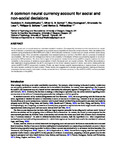A common neural account for social and non-social decisions
| dc.contributor.author | Fouragnan, Elsa | |
| dc.contributor.author | Arabadzhiyska, DH | |
| dc.contributor.author | Garrod, OGB | |
| dc.contributor.author | Philippe G, S | |
| dc.contributor.author | Marios G., P | |
| dc.date.accessioned | 2022-10-29T16:53:34Z | |
| dc.date.issued | 2022-10-24 | |
| dc.identifier.issn | 1529-2401 | |
| dc.identifier.issn | 1529-2401 | |
| dc.identifier.uri | http://hdl.handle.net/10026.1/19784 | |
| dc.description.abstract |
<jats:p>To date, social and nonsocial decisions have been studied largely in isolation. Consequently, the extent to which social and nonsocial forms of decision uncertainty are integrated using shared neurocomputational resources remains elusive. Here, we address this question using simultaneous electroencephalography (EEG)-functional magnetic resonance imaging (fMRI) in healthy human participants (young adults of both sexes) and a task in which decision evidence in social and nonsocial contexts varies along comparable scales. First, we identify time-resolved build-up of activity in the EEG, akin to a process of evidence accumulation (EA), across both contexts. We then use the endogenous trial-by-trial variability in the slopes of these accumulating signals to construct parametric fMRI predictors. We show that a region of the posterior-medial frontal cortex (pMFC) uniquely explains trial-wise variability in the process of evidence accumulation in both social and nonsocial contexts. We further demonstrate a task-dependent coupling between the pMFC and regions of the human valuation system in dorso-medial and ventro-medial prefrontal cortex across both contexts. Finally, we report domain-specific representations in regions known to encode the early decision evidence for each context. These results are suggestive of a domain-general decision-making architecture, whereupon domain-specific information is likely converted into a “common currency” in medial prefrontal cortex and accumulated for the decision in the pMFC.</jats:p><jats:p><jats:bold>SIGNIFICANCE STATEMENT</jats:bold>Little work has directly compared social-versus-nonsocial decisions to investigate whether they share common neurocomputational origins. Here, using combined electroencephalography (EEG)-functional magnetic resonance imaging (fMRI) and computational modeling, we offer a detailed spatiotemporal account of the neural underpinnings of social and nonsocial decisions. Specifically, we identify a comparable mechanism of temporal evidence integration driving both decisions and localize this integration process in posterior-medial frontal cortex (pMFC). We further demonstrate task-dependent coupling between the pMFC and regions of the human valuation system across both contexts. Finally, we report domain-specific representations in regions encoding the early, domain-specific, decision evidence. These results suggest a domain-general decision-making architecture, whereupon domain-specific information is converted into a common representation in the valuation system and integrated for the decision in the pMFC.</jats:p> | |
| dc.format.extent | 9030-9044 | |
| dc.format.medium | Print-Electronic | |
| dc.language | en | |
| dc.language.iso | en | |
| dc.publisher | Society for Neuroscience | |
| dc.rights | Attribution-NoDerivatives 4.0 International | |
| dc.rights.uri | http://creativecommons.org/licenses/by-nd/4.0/ | |
| dc.subject | EEG | |
| dc.subject | decision making | |
| dc.subject | evidence accumulation | |
| dc.subject | fMRI | |
| dc.subject | modeling | |
| dc.subject | Young Adult | |
| dc.subject | Male | |
| dc.subject | Female | |
| dc.subject | Humans | |
| dc.subject | Decision Making | |
| dc.subject | Magnetic Resonance Imaging | |
| dc.subject | Frontal Lobe | |
| dc.subject | Electroencephalography | |
| dc.title | A common neural account for social and non-social decisions | |
| dc.type | journal-article | |
| dc.type | Journal Article | |
| dc.type | Research Support, Non-U.S. Gov't | |
| plymouth.author-url | https://www.ncbi.nlm.nih.gov/pubmed/36280264 | |
| plymouth.issue | 48 | |
| plymouth.volume | 42 | |
| plymouth.publication-status | Published | |
| plymouth.journal | Journal of Neuroscience | |
| dc.identifier.doi | 10.1523/JNEUROSCI.0375-22.2022 | |
| plymouth.organisational-group | /Plymouth | |
| plymouth.organisational-group | /Plymouth/Faculty of Health | |
| plymouth.organisational-group | /Plymouth/Faculty of Health/School of Psychology | |
| plymouth.organisational-group | /Plymouth/REF 2021 Researchers by UoA | |
| plymouth.organisational-group | /Plymouth/REF 2021 Researchers by UoA/UoA04 Psychology, Psychiatry and Neuroscience | |
| plymouth.organisational-group | /Plymouth/Users by role | |
| plymouth.organisational-group | /Plymouth/Users by role/Academics | |
| plymouth.organisational-group | /Plymouth/Users by role/Researchers in ResearchFish submission | |
| dc.publisher.place | United States | |
| dcterms.dateAccepted | 2022-08-23 | |
| dc.rights.embargodate | 2022-11-1 | |
| dc.identifier.eissn | 1529-2401 | |
| dc.rights.embargoperiod | Not known | |
| rioxxterms.funder | Medical Research Council | |
| rioxxterms.identifier.project | Mapping the neural basis of credit assignment for a new targeted intervention in addiction | |
| rioxxterms.versionofrecord | 10.1523/JNEUROSCI.0375-22.2022 | |
| rioxxterms.licenseref.uri | http://creativecommons.org/licenses/by-nd/4.0/ | |
| rioxxterms.type | Journal Article/Review | |
| plymouth.funder | Mapping the neural basis of credit assignment for a new targeted intervention in addiction::Medical Research Council |



